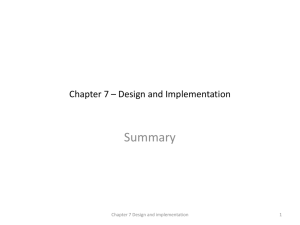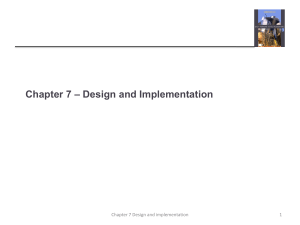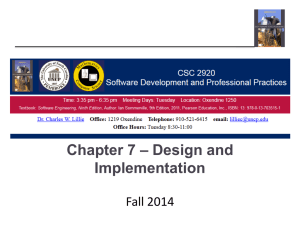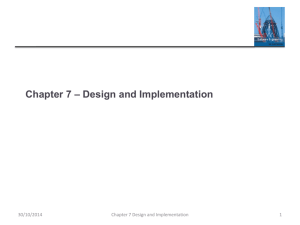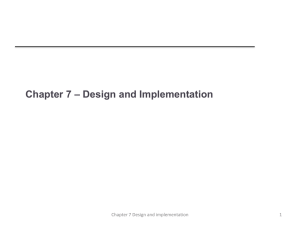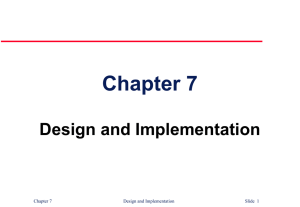Topics covered Design and implementation Build or buy Object
advertisement
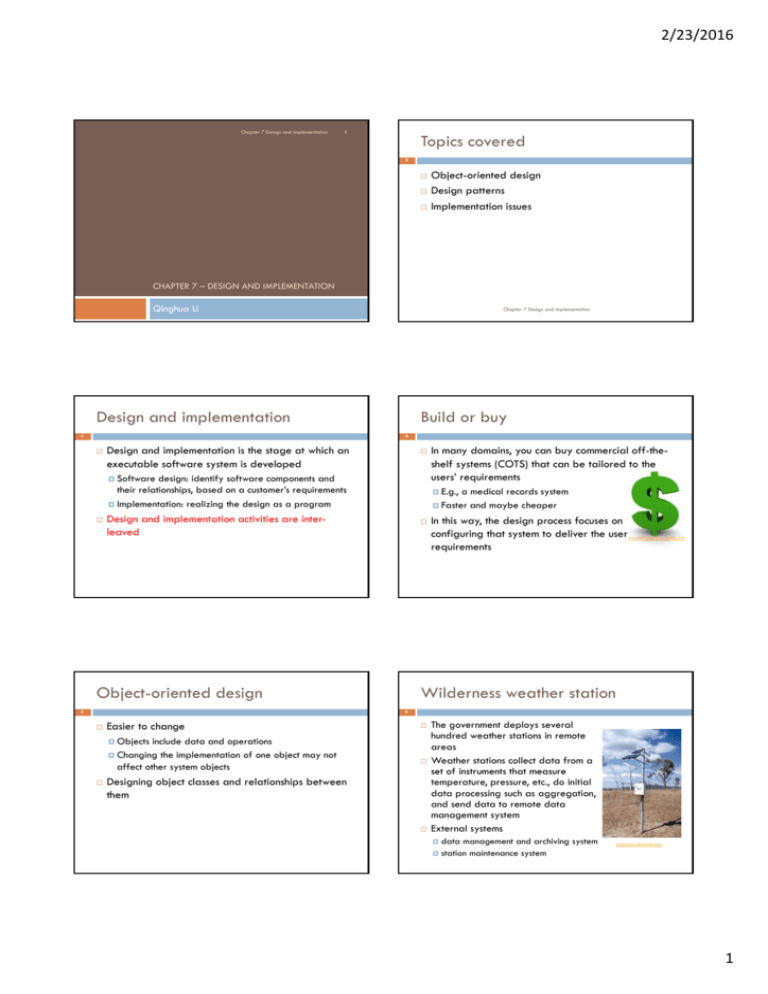
2/23/2016 Chapter 7 Design and implementation 1 Topics covered 2 Object-oriented design Design patterns Implementation issues CHAPTER 7 – DESIGN AND IMPLEMENTATION Qinghua Li Chapter 7 Design and implementation Design and implementation 3 Build or buy 4 Design and implementation is the stage at which an executable software system is developed Software design: identify software components and their relationships, based on a customer’s requirements Implementation: realizing the design as a program E.g., a medical records system and maybe cheaper Faster Design and implementation activities are interleaved Object-oriented design 5 In many domains, you can buy commercial off-theshelf systems (COTS) that can be tailored to the users’ requirements In this way, the design process focuses on configuring that system to deliver the user requirements www.dallassprinklerrepairtx.com Wilderness weather station 6 Easier to change include data and operations Changing the implementation of one object may not affect other system objects Objects Designing object classes and relationships between them The government deploys several hundred weather stations in remote areas Weather stations collect data from a set of instruments that measure temperature, pressure, etc., do initial data processing such as aggregation, and send data to remote data management system External systems data management and archiving system station maintenance system commons.wikimedia.org 1 2/23/2016 Context and interaction models Object-oriented design process stages 7 8 Activities Define the context and external interactions with the system Design the system architecture the principal system objects Develop design models Specify object interfaces Identify A system context model is a structural model that demonstrates the other related systems in the environment of the system being developed An interaction model is a dynamic y model that shows how the system interacts with its environment as it is used. Chapter 7 Design and implementation Weather station use cases System context for the weather station 9 10 Use case description—Report weather 11 Object-oriented design process stages 12 System Weather station Use case Report weather Actors Weather information system, Weather station Description The weather station sends a summary of the weather data that has been collected from the instruments in the collection period to the weather information system. The data sent are the maximum system maximum, minimum minimum, and average ground and air temperatures; the maximum, minimum, and average air pressures; the maximum, minimum, and average wind speeds; the total rainfall; and the wind direction as sampled at five-minute intervals. Stimulus The weather information system establishes a satellite communication link with the weather station and requests transmission of the data. Response The summarized data is sent to the weather information system. Comments Weather stations are usually asked to report once per hour but this frequency may differ from one station to another and may be modified in the future. Activities Define the context and external interactions with the system Design the system architecture Identify the principal system objects Develop design models Specify object interfaces 2 2/23/2016 Architectural design 13 14 High-level architecture of the weather station Identify the major components and their interactions May organize the components using an architectural pattern Architecture of data collection system 15 Object-oriented design process stages 16 Activities Define the context and external interactions with the system Design the system architecture Identify the principal system objects Develop design models Specify object interfaces Object class identification 17 Approaches to identification 18 Often a difficult part of object oriented design is no 'magic formula' for object identification. It relies on the skill, experience and domain knowledge of system designers Object identification is an iterative process There Use a grammatical approach based on a natural language description of the system Noun: possible object Verb: possible method Base the identification on tangible things in the application domain Use a scenario-based analysis. The objects, attributes and methods in each scenario are identified. 3 2/23/2016 Weather station description 19 Weather station object classes 20 A weather station is a package of software controlled instruments which collects data, performs some data processing and transmits this data for further processing. The instruments include air and ground thermometers,, an anemometer,, a wind vane,, a barometer g and a rain gauge. Data is collected periodically. Object class identification based on the tangible hardware and data in the system: Ground thermometer, Anemometer, Barometer Weather station When a command is issued to transmit the weather data, the weather station processes and summarises the collected data. The summarised data is transmitted to the mapping computer when a request is received. The basic interface of the weather station to its environment. It therefore reflects the interactions identified in the use-case model. Weather data Weather station object classes 21 Application domain objects that are ‘hardware’ objects related to the instruments in the system. Encapsulates the summarized data from the instruments. Object-oriented design process stages 22 Activities Define the context and external interactions with the system Design the system architecture Identify the principal system objects Develop design models Specify object interfaces Design models 23 Examples of design models 24 Design models show the objects and object classes and relationships between these entities. Static models describe the static structure of the system y in terms of object j classes and relationships p Dynamic models describe the dynamic interactions between objects. Subsystem models that show logical groupings of objects into coherent subsystems. Sequence models that show the sequence of object interactions. State machine models that show how individual objects change th i state their t t in i response to t events. t 4 2/23/2016 Subsystem models 25 Sequence models 26 Shows how the design is organised into logically related groups of objects. Sequence models show the sequence of object interactions that take place Objects are arranged horizontally across the top; is represented vertically so models are read top t bottom; to b tt Interactions are represented by labelled arrows Time 27 Sequence diagram describing data collection State diagrams 28 State diagrams are used to show how objects respond to different service requests and the state transitions triggered by these requests. Useful high-level models of a system or an object’s runtime behavior. behavior You don’t usually need a state diagram for all objects Weather station state diagram 29 Object-oriented design process stages 30 Activities Define the context and external interactions with the system Design the system architecture Identify the principal system objects Develop design models Specify object interfaces 5 2/23/2016 Interface specification 31 Weather station interfaces 32 Interfaces: what an object can do Object interfaces have to be specified so that the objects and other components can be designed in parallel. Designers should avoid designing the interface representation b t should but h ld hid hide thi this in i the th object bj t itself. it lf Objects may have several interfaces which are viewpoints on the methods provided. Questions? Design patterns 33 34 A design pattern is a way of reusing abstract knowledge about a problem and its solution "Each pattern describes a problem which occurs over and over again in our environment, environment and then describes the core of the solution to that problem, in such a way that you can use this solution a million times over, without ever doing it the same way twice” – Christopher Alexander Chapter 7 Design and implementation Pattern elements 35 The Observer pattern 36 Name A Name Description meaningful pattern identifier Problem description When Solution description a concrete design but a template for a design solution that can be instantiated in different ways Consequences The the pattern is applicable Not results and trade-offs of applying the pattern Observer. Separates the display of object state from the object itself allows alternative displays to be provided When the object j state changes, g , all displays p y are automaticallyy notified and updated to reflect the change Problem description Solution description Consequences Used when multiple displays of state are needed. See slide with UML description. Optimisations to enhance display performance are impractical. Chapter 7 Design and implementation 6 2/23/2016 37 Multiple displays using the Observer pattern A UML model of the Observer pattern 38 Design problems and patterns 39 Design problems (cont’d) 40 Tell several objects that the state of some other object has changed: Observer pattern Provide a standard way of accessing the elements in a collection, irrespective of how that collection is i l implemented: d Iterator It t pattern tt Allow for the possibility of extending the functionality of an existing class at run-time: Decorator pattern Ensure a class has only one instance, and provide a global point of access to it: Singleton pattern Represent an operation to be performed on the elements of an object structure, and define a new operation without changing the classes of the elements on which it operates: Visitor pattern Design Patterns: Elements of Reusable Object-Oriented Software Erich Gamma, Richard Helm, Ralph Johnson, John Vlissides of Four” “Gang Wiki: Implementation issues 41 More resources Software design pattern Reuse 42 Reuse Most modern software is constructed by reusing existing components or systems Configuration management Keep track of the many different versions of each software component p Development tools Tools that enable more efficient development From the 1960s to the 1990s, most new software was developed from scratch The only significant reuse was the reuse of functions and objects in programming language libraries Costs and schedule pressure rendered this approach infeasible, especially for commercial and Internet-based systems 7 2/23/2016 Reuse levels 43 Reuse costs 44 The abstraction level Reuse objects from a library rather than writing the code yourself The component level The object level Reuse knowledge of successful abstractions in the design, e.g., architecture pattern Reuse collections of objects which are called components of application systems The costs of the time spent in looking for proper reusable software The costs of buying the reusable software The costs of adapting and configuring the reusable software components/systems for your system The costs of integrating reusable software elements with each other and with your new code The system level Reuse entire application systems Configuration management 45 Configuration management activities 46 The general process of managing a changing software system Change by different people Change g at different times Version management keep track of the different versions of software components. coordinate development by several programmers. System integration help developers define what versions of components are used to create each version of a system Problem tracking allow users to report bugs and other problems allow all developers to see who is working on these problems and when they are fixed Chapter 7 Design and implementation Configuration management Tools 47 Development tools 48 Comprehensive tools ClearCase Separate tools Version control: Subversion System integration: GNU build (Unix make) Bug tracking: Bugzilla An integrated compiler and syntax-directed editing system that allows you to create, edit and compile code. A language debugging system. Graphical editing tools, such as tools to edit UML models. Testing tools, such as Junit that can automatically run a set of tests on a new version of a program. Project support tools that help you organize the code for different development projects Chapter 7 Design and implementation 8 2/23/2016 49 Integrated development environments (IDEs) Software development tools are often grouped to create an IDE NetBeans, Eclipse, Microsoft Visual Studio IDEs are created to support development in a specific programming language such as Java 9
